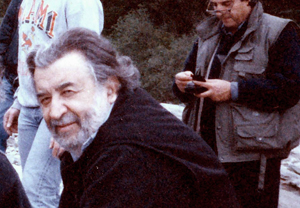The story behind the movie "Un cuore altrove".
My mother was born on Via degli Angeli, some tens of meters of Porta Castiglione and therefore she lived all her youth and teenage life near the Istituto Cavazza. She kept a beautiful and imaginative memory of the noble institution's guests going back one Sunday in the fall at the beginning of the Second World War.
It was on that Sunday, in the Church of Porta Castiglione, that fourteen single blind women of the Istituto married with sighted men from Bologna.
The blind girls arrived at the church walking, wearing their long white dresses, holding hands. The were preceded by a sighted nun who led the way. They were watched by curious onlookers.

The girls who were going to get married were laughing, teasing one another, the funniest thing being the exchange (in a sense not impossible) of husband. The fourteen husband-to-be, dressed in white shirts, were also laughing and waiting in line on the church's large square, the Arsenale group behind them playing opera music.
So, on that October morning, every blind woman who had found a sweetheart during the course of the previous spring or summer got married. The girls named Bulgarelli, Wanda, Bragalini, Gianna, Melega, Comaschi and Rita all married without a pimple (those with pimples never would have married), Tania also, the girl from Pistoia who was always so quiet and the one from Castelfranco who knew how to play the waltz.
Their sweethearts were men with wide or narrow shoulders who had not been able to find sighted wives though they did try to. They were short or tall men who had found such women but who had died or ran away with who knows whom and who knows where without even leaving a small note as they should have. They were men, heavy or skinny, totally free towards society or the Holy Church.

They may have been men who sighted women had refused because of what they looked like, because of their age or, in most cases, because they were so terribly shy to declare their love to women who looked them in the eyes.
People in charge at the Istituto had gathered the necessary information on their legal status, their morality, the absence of genetic flaws and on employment that guaranteed support and dignity of the new couple.
It was a magnificent ceremony that everyone expected to be moving, but which was not in reality, even when the blind girls, one by one, said "yes" promising eternal love to men whose appearance they could only imagine.
The ceremony was then moved to the gardens behind the church where all spouses and guests sat at a long table and were served meat sauce with rice and fish steak. Considering the solemnity of the ceremony, it was a menu considered inadequate by the parish priest who was also upset by the wedding cake covered with alkermes liqueur, each couple, one at a time, cutting in the first slice, squashing the cake.
At the moment of the toast, the girl Marcelli who was the most cultured, said some verses by Vate, "Love presideth o’er this feast,
Those who serve him gather round. Be there one by envy bound,
Take he leave, for thus at least He will go and not be chased!" verses of which meaning escaped everyone there except the priest who thought they were absolutely out of place. Of this sort of marriage my mother knew little.
The only certain thing was that these smiling husbands, after only a few months, would be dressed in uniforms to fight the most bloody conflict within the memory of man.